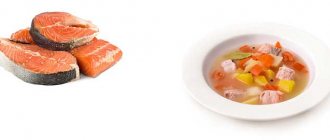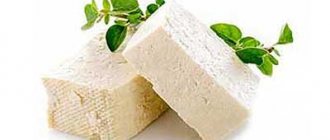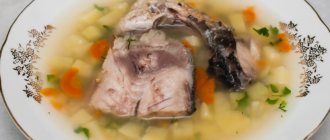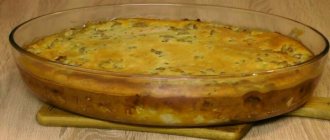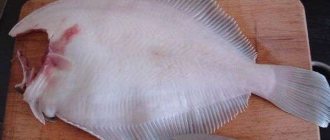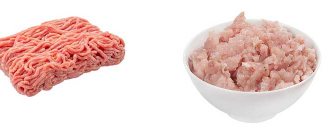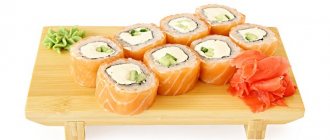By regularly eating salmon, you saturate your body with vitamins and minerals. The vitamin and mineral composition of fish is represented by vitamins B, A, C, E, D, and the minerals selenium, zinc and chromium.
Calorie content of lightly salted salmon per 100 grams is 195.3 kcal. In a 100-gram serving of this fish:
- 23 g protein;
- 13 g fat;
- 0 g carbohydrates.
Lightly salted salmon contains a lot of fatty acids Omega 3, Omega 6, selenium, fluorine, zinc, sodium, calcium, vitamins A, E, C, PP.
Contraindications to the use of the product are exacerbations of diseases of the liver, kidneys, stomach, and intestines. Fish will have to be abandoned if water-salt metabolism is disrupted.
Calorie content of oven-baked salmon per 100 grams
Calorie content of oven-baked salmon per 100 grams is 101 kcal. In a 100 gram serving of fish:
- 8.88 g protein;
- 5.42 g fat;
- 4.79 g carbohydrates.
To prepare baked salmon you need:
- Place 120 g of onion cut into rings on a sheet of foil;
- add 120 g of coarsely grated carrots to the onion;
- Sprinkle 200 g of salmon fillet with lemon juice and place on onions and carrots;
- wrap the edges of the foil so that the juice of the fish and vegetables remains inside and does not flow out onto the baking sheet;
- salt the fish to taste;
- bake the salmon in the oven at 200 °C for 25 - 30 minutes.
Baking salmon in cream sauce
This is a classic way to cook steaks; it is more convenient to calculate their quantity by portion. This way the dish will be eaten immediately. The aromatic red fish is easy to prepare. To do this, it is important to prepare fresh and correct products. The dish turns out amazingly aromatic and juicy, a real delicacy!
Ingredients:
- salmon (portioned steaks) – 500 gr.;
- cream (low-fat, 10%) – 300 ml;
- egg (yolks separately) – 3 pcs.;
- mustard – 2 tsp;
- dried basil – 1 tsp;
- parsley - a bunch;
- rosemary – branch;
- potatoes – 300 gr.;
- pepper, salt.
1. If the potatoes are young, I boil them “in their jackets” without peeling. The regular one can be peeled and pureed, or cut into large pieces. This is a side dish.
2. Carefully cut the steaks in half, remove the skin and cut out the bone in the middle. Place the resulting 4 pieces in a deep glass mold. I season them with spices, coating both sides.
3. Sauce. I mix 3 ingredients: mustard + 3 yolks and cream. I mix everything thoroughly with a whisk. Add spices (basil, pepper). Pour the prepared sauce over the fish and place a sprig of rosemary on top.
4. Preheat the oven in advance, setting it to 180 degrees. Place a baking sheet there and bake for 20-25 minutes. I serve the fish hot with potatoes.
Didn't manage to cook the dish? Don't be shy, ask me personally.Go
Calorie content of smoked salmon per 100 grams
Calorie content of smoked salmon per 100 grams is 203 kcal. In 100 g of fish:
- 22.6 g protein;
- 12.4 g fat;
- 0 g carbohydrates.
Despite the fact that smoked salmon contains a lot of fatty acids, chlorine, nickel, fluorine, molybdenum, potassium, calcium, magnesium, iron, chromium, vitamins A, PP, this product is not recommended to be eaten in large quantities and often. Otherwise, malfunctions in the gastrointestinal tract, exacerbation of diseases of the liver, kidneys, pancreas, and the appearance of swelling cannot be ruled out.
Option 5: Grilled salmon with ginger
Recipe for an amazing marinade for grilled salmon. To cook it. You will need a fresh and juicy ginger root. There is no need to try to replace it with powder from a bag; such spices do not have a pronounced aroma and give a completely different taste.
Ingredients
- 3 steaks;
- 30 ml lemon juice;
- 2 tsp. grated ginger;
- 25 ml olive oil;
- 0.3 tsp. pepper mixtures;
- 2 cloves of garlic;
- 70 g green onions;
- salt.
How to cook
Grate or chop the garlic cloves, add ginger to them, add lemon juice. You can use lime. Salt, pepper and grind well until a pleasant aroma emerges, essential oils should be released.
Add olive oil to the aromatic mixture and stir again. Lubricate the steaks with the prepared mixture. Place in a container, cover, leave for an hour, you can keep it longer.
Remove the steaks from the marinade and be sure to shake off all the adhering pieces of ginger and garlic so that they do not burn. The grill should be hot by now. Fry the fish on both sides.
Chop the green onions and place on flat plates. We place salmon steaks on top of it. Additionally, you can garnish with lemon.
There is a similar marinade for salmon with ginger and coconut milk; in this version it is not necessary to add lemon juice.
Benefits of salmon
With regular consumption of boiled and steamed salmon, the following beneficial properties of fish appear:
- salmon is enriched with Omega 3 and Omega 6 fatty acids, which saturate the body with energy, have an anti-stress effect, and reduce the level of bad cholesterol;
- Numerous studies have proven that the beneficial substances of salmon are necessary for the restoration of cell membranes of brain cells and retina;
- salmon normalizes the functioning of the heart and blood vessels, strengthens the immune system;
- when boiled fish is included in the diet, the required level of leptin is maintained, which restores metabolism, accelerating fat burning processes;
- the beneficial properties of salmon have been proven to prevent senile dementia, improve the condition of hair and skin;
- Fish melatonin is necessary for normalizing sleep;
- Salmon vitamins and minerals are important for restoring central nervous system functions.
Benefits and contraindications
The set of vitamins and microelements listed above allows salmon to have a comprehensive healing effect on the human body. It increases immunity, improves blood composition, strengthens the heart and blood vessels, bones, tooth enamel, improves skin condition, normalizes digestion, and regulates the functioning of internal organs. Salmon is very useful for the functioning of the brain and nervous system - it not only increases performance and reduces fatigue, but also improves mood and sleep and helps to resist stress. Zinc contained in salmon enhances the body's protective and regenerative powers.
Due to its calorie content, salmon is an excellent source of energy and a good prophylactic against anemia, atherosclerosis, ischemia, hypertension, and senile dementia. It is useful for children and pregnant women to use, as it helps the fetus and child develop normally. Also, the meat of this fish prevents the formation of cancer cells.
Salmon is very well absorbed by the body, so it can become a useful substitute for “difficult” protein products to digest, such as animal and poultry meat. Since it contains no carbohydrates, the body rearranges metabolic processes when consuming salmon to obtain energy from fats, that is, it starts the process of fat burning, therefore, despite the rather high calorie content of salmon, it is very useful for weight loss, of course, with moderate consumption.
Despite the fact that this fish has virtually no contraindications, it is not recommended for obesity due to the high fat content and calorie content of salmon
. It can also cause individual allergic reactions. Salmon should be consumed with caution in case of chronic liver diseases, gastrointestinal ulcers, urolithiasis and cholelithiasis, thyroid dysfunction, as well as active pulmonary tuberculosis.
Harm to salmon
Contraindications to eating salmon are:
- developed food allergies to fish;
- the period of breastfeeding, since in this case malfunctions in the baby’s gastrointestinal tract are possible and skin rashes may appear;
- liver and kidney diseases (this point is relevant for salted and lightly salted fish).
Research by American doctors has shown that mercury accumulates in salmon meat, which can cause severe food intoxication. When eating fried fish, you gain excess weight and the risk of exacerbation of cholecystitis and pancreatitis increases.
4.7 out of 5
Red fish is not only an exquisite delicacy, but also the most valuable food product in the human diet. Doctors recommend consuming red fish at least 2 times a week. Salmon is useful for both children and adults. It can be salted, baked in foil, boiled, fried, steamed, served with various side dishes and sauces.
Many people believe that the fat content and calorie content of salmon is too high, and for this reason they exclude it from the menu.
In reality, salmon consumption has no effect on weight gain. Despite the high calorie content of salmon, it contains a whole range of useful substances that support slimness, youth and health.
How to distinguish from trout?
Anyone who has bought salmon for the table at least once in their life might have noticed that this type of fish is quite expensive. However, there is one more fish, which very often, by its appearance, an inexperienced buyer can mistake for salmon.
Sellers have long noticed that cheaper trout can easily be passed off as salmon. That is why it is better to know the main differences between these two types of fish, so as not to fall for the bait of unscrupulous people.
Differences in size and color
First of all, look at the size of the fish. Typically, a salmon carcass sold in a store will weigh approximately 6-7 kg, while trout only reaches 4. If you put them side by side, the difference will be quite obvious. Very often, female salmon are much larger than males.
In appearance, salmon is a rather beautiful fish with a silvery tint. The color of its flesh varies from pink to bright red. Quite often it depends on the period in which it was caught.
Trout, on the other hand, has quite variegated scales. Near the dorsal fin, it usually smoothly flows from green to black, and its abdomen is white or gray. At the same time, also take a closer look at the sides of the trout: they often have small red or white spots on them.
Body structure
As mentioned earlier, salmon’s body shape is somewhat reminiscent of a torpedo. At the same time, the trout must have a belly, which its brother does not have at all. The next important difference is the fish's head. Since the salmon itself is larger, its head is much larger and slightly elongated. If you look closely at the trout, you will notice that its head is small and round.
If you carefully compare these two types of fish, you will notice that salmon has more developed and longer front fins, and larger scales. In trout it is very small.
In fact, one can argue endlessly about which is better, trout or salmon. The taste of their meat is quite similar, so only true gourmets can catch the nuances, but by their appearance it is quite easy for any buyer to distinguish them.
Nutritional and energy value
Atlantic salmon itself cannot be called an absolutely dietary fish. At the same time, almost any processing, such as frying, salting, smoking and other methods of preparation, only increases its calorie content. If you are watching your diet, it is better to choose boiling or steaming. When using these two methods, the proportion of fat is reduced, and the fish retains significantly more vitamins.
Salmon itself is quite a fatty fish, because the percentage of fat in it is more than 40. The energy value of fresh fish reaches approximately 220 Kcal, and the calorie content is about 155. But at the same time, its nutritional value is simply amazing.
Below is a table that shows the calorie content and nutritional value of salmon prepared using different methods.
| Type of salmon | Calorie content | Squirrels | Fats |
| Salty | 203 Kcal | 22 gr | 12 g |
| Lightly salted | 202 Kcal | 22 gr | 12 g |
| Steamed salmon | 142 Kcal | 20 gr | 7 g |
| Boiled | 150 Kcal | 20 gr | 2.5 g |
| Baked | 211 Kcal | 24 g | 14 g |
| Salmon steak | 200 Kcal | 23 g | 12 g |
As you can see from the table, salmon contains absolutely no carbohydrates, so as a side dish for it it is better to prepare those foods that will help maintain nutritional balance.
Calorie content of salmon and its benefits for the body
Salmon is caught in the wild or bred in special fish farms. In any case, the benefits of natural salmon are extremely great. It contains vitamins of groups B, A, C, D, H, PP. Salmon includes a huge complex of nutrients: phosphorus, calcium, iodine, potassium, magnesium, fluorine, zinc.
The value of salmon lies in a large amount of fatty acids, namely omega-3. This acid is responsible for the elasticity and youth of the skin, cholesterol levels and the functioning of the nervous system. Regular consumption of healthy, high-calorie salmon helps strengthen the immune system, improve the functioning of the digestive system, and normalize blood circulation.
In salmon, calories are not as important as its amazing composition
. Eating red fish helps cope with depression, despondency, and emotional stress. People who often eat salmon are better able to cope with stress and seasonal apathy. Salmon also has a positive effect on brain function, improving blood circulation and increasing the elasticity of blood vessels.
The average calorie content of salmon is 220 kcal per 100 g. Of this, 20.8 g are proteins, 15.1 g are fats. People who carefully monitor the indicators on the scale should not be afraid of the amount of fat in the salmon and look at how many calories are in the salmon. Fats are different and have different functions. The fats obtained from salmon are exclusively beneficial. Salmon preserves its quality best when baked in the oven, steamed or grilled. The fried product is not suitable for dietary nutrition, since the calorie content in such salmon increases significantly.
Different countries have their own traditions of preparing salmon. In Japan, salmon is an ingredient for sushi; in Italy, they like to fry red fish in batter; in Finland, salmon is served with a special marinade. However, lightly salted salmon is very popular everywhere, with a calorie content of 202 kcal per 100 g.
.
Salted fish retains all the beneficial substances inherent in a fresh product. It contains a colossal amount of melatonin, which affects cell rejuvenation and regeneration, as well as sleep quality. Lightly salted salmon does not differ in calorie content and set of minerals from its raw counterpart. It is an excellent preventive measure for cardiovascular diseases, saturates the body with healthy cholesterol, prolongs youth and beauty.
Lightly salted and fresh salmon for diets
You can easily purchase salmon fresh, lightly salted or frozen, and you can also easily cook it. Salmon fillet or steak is very tasty baked in foil or grilled with dill, spices and lemon juice. As a result, you will get juicy and aromatic red fish meat that will not leave you indifferent. The calorie content of salmon in this form will not harm you if you eat no more than 100 grams of it per day.
While following a diet, salmon can be steamed as a valuable protein dinner. Rice goes very well with salmon, so it can be served (in small quantities) as a side dish. Do not forget that rice and fish should not be too salted and peppered, so as not to interrupt the delicate taste of the dish. The calorie content of salmon for such a dinner will not make you worry if you eat it at least 5 hours before bedtime.
Do not forget that you should also eat more fresh vegetables or light vegetable salads with fish proteins, this will help the body maintain proper metabolism. The ideal option here would be a vegetable salad with lightly salted salmon, seasoned with a small amount of olive oil. The main rule is that no matter how tasty the salmon you cook is, do not overeat. Remember to eat properly, exclude fried and fatty foods from your diet.
Everyone knows that any fish is healthy. Many nutritionists and conventional doctors advise eating more fish and less meat. But, even if you are not a seafood lover, small amounts of these products should be consumed.
Of course, one of the most popular sea creatures is salmon. The calorie content of salmon is very high, and despite this, it is excellent for dietary nutrition.
Salmon contains a lot of useful substances. These are vitamins of group B, as well as A, C, D, E and PP. It also contains many trace elements such as sodium, phosphorus, potassium, fluorine, iodine, sulfur, chlorine and others.
Yes, this marine inhabitant is not low-calorie. However, due to the fact that it contains fats and proteins, but absolutely no carbohydrates, the dish you eat will not put extra centimeters on your waist.
Moreover, this product contains the Omega-3 amino acid and several other fatty acids, which promote the breakdown of fat and have an extremely beneficial effect on metabolism. The calorie content of salmon is quite high and yet it is perfect for people who want to lose weight.
In terms of its properties, this sea creature is simply a Goldfish. It is recommended for use by both children and adults. It will be useful for men and women, people engaged in mental work and workers with heavy physical activity.
How many calories are in salmon?
- Salted and lightly salted salmon – 202 kcal;
- Steamed salmon – 153 kcal;
- Boiled salmon – 167 kcal;
- Fried salmon – 197 kcal;
- Smoked salmon – 169 kcal;
- Baked salmon – 197 kcal;
- Salmon fish soup – 67 kcal;
- Salmon sandwich – 93 kcal.
Salmon fish soup and light sandwiches on whole grain bread are considered dietary products. These dishes contain minimal caloric content of salmon.
, so they can be eaten in large quantities and often. A sandwich with a piece of salmon and a thin layer of butter is a wonderful breakfast for a child. A light and nutritious sandwich in the morning will help you get into the mood for work and give you energy.
A contraindication to consuming high-calorie salmon may be intolerance to seafood and fish. Abuse of the product also leads to problems. Excessive intake of fatty acids is prohibited in case of dysfunction of the thyroid and pancreas, acute forms of diseases of the stomach, liver, and open form of tuberculosis. If you have chronic diseases, you should consult with your doctor, who will determine the permissible salmon consumption rate.
Nutritionists and doctors advise paying attention not only to how many calories are in salmon, but also to its anti-aging abilities. Salmon has an amazing effect on the skin, providing a tightening effect. Experts note that regular consumption of salmon leads to skin regeneration, making it more radiant, soft, and elastic. Thanks to fatty acids, the skin is moisturized and nourished, which significantly improves its appearance.
The high calorie content of salmon does not affect weight
, but on the contrary promotes the breakdown of fats and weight loss. To really prolong youth, you need to eat healthy foods, stop smoking, drinking coffee, alcohol and move more.
Popular articles
Nov-28-2012
Calorie content of salmon
Salmon is a predatory fish of the Salmon family, with dense scales of a silvery color. During the spawning period, the color of the fish becomes dark gray, and orange and red spots appear on the sides and head. Most salmon species are anadromous - they are born in fresh water, migrate to salt water sources, and return to fresh water to spawn.
Cooked salmon meat is quite fatty, but not high in calories, has a very delicate and juicy taste, is low in bone and is colored pink-red. The calorie content of salmon varies depending on the type of fish; for example, chicken salmon is much fattier and higher in calories than salmon. In nature, there are 23 species of salmon, including chum salmon, salmon, nelma, pink salmon, coho salmon and trout, which are most often used in cooking.
Regardless of how many calories are in salmon, this tasty and rather expensive fish is widely used in many dietary diets.
Dietary properties of salmon:
Who doesn't love fish? On any holiday, and not only, fish dishes are a table decoration. And the most “beautiful” decoration is, of course, red fish, or salmon. It is classified among the so-called fatty varieties. Therefore, many, especially women, have a question: what calorie content does salmon have, and will dishes made from it cause extra pounds? I can say right away: they won’t. Moreover, boiled or steamed salmon dishes. Well, how is it useful?
Like many types of fish, it is rich in so-called fatty acids. But this fish contains the most of them.
She is not offended by minerals and proteins that are beneficial to human health. There are vitamins and unsaturated fats in sufficient quantities.
A little more detail about fatty acids, since their presence in food products is very important for human health. Of the fatty acids found in it, the most important is the so-called Omega-3. This compound is credited with the ability to rejuvenate the human body, give a boost of energy and prolong youth. Well, who doesn’t want to prolong their youth? At least a little...
Well, in addition to these very beneficial properties, Omega-3 can reduce the amount of so-called stress hormones, which negatively affect the functioning of the cardiovascular system, causing spasm of the heart arteries. And this is not the only harmful effect of these hormones on the body. They are also responsible for emotional stress, bad mood, and even depressive states. And fish, as a food product, can relieve these undesirable effects, thereby maintaining your health.
In addition to all this, this fish is very useful for people engaged in mental work, as it has a positive effect on the blood vessels of the brain, increasing their elasticity, improving blood circulation, which increases the level of oxygen consumption by brain cells.
It also contains more than twenty very useful macro and microelements, such as chlorine, sulfur, iodine, magnesium, calcium and others. There are also quite a significant amount of vitamins, such as B vitamins, vitamin A, D, C, PP and others.
Is it useful to everyone? Not everyone. After all, there are also people with allergic reactions to fish and seafood. Some people on a diet are afraid of the supposedly high calorie content of salmon, which, by the way, is completely in vain. But people with cholelithiasis and urolithiasis can be harmed by the unsaturated fatty acids contained in abundance. Consuming salmon in excessive quantities may also be harmful to patients with chronic liver diseases and inflammatory processes in the gastrointestinal tract.
Calorie content of dishes
As mentioned above, the calorie content of salmon depends on the method of its preparation. It can be both extremely useful and quite harmful. But that's not all. After all, the amount of nutrients entering your body depends on what dish you eat. And the more benefits food brings you, the better.
- 100 grams of raw product - 204 Kcal;
- 100 grams of lightly salted salmon - 195 Kcal;
- Salted fish 100 grams - 205 Kcal;
- 100 grams of boiled product - 189 Kcal;
- 100 grams of fried food - 194.4 Kcal;
- 100 grams of steamed food - 197 Kcal.
It is impossible to say exactly how many calories there will be in a particular dish. After all, this parameter depends not only on the method of preparing the dish, but also on where its main ingredient was caught.
Fish caught in the sea has less calories than fish raised in special nurseries. This happens because the specially raised fish eats a certain food and moves very little. In nurseries it grows larger and therefore fatter.
Of course, salmon is an extremely healthy dish in our diet; it carries enormous benefits. It has an extremely beneficial effect on the human body, and the importance of rare amino acids simply cannot be overestimated. Omega-3 is an extremely useful amino acid that has a beneficial effect on many processes in the body. But nevertheless, we should not forget that everything is good in moderation. And you still shouldn’t overeat this product. Otherwise, you can not only get health problems, but also gain extra centimeters in the waist and gain unnecessary kilograms.
Salmon, or Atlantic salmon, is a valuable and rare fish of the salmon family, living in the waters of the Arctic and Atlantic oceans, in the basins of the Barents, Baltic and White seas, in Lakes Ladoga and Onega. Representatives of this species have an elongated body covered with small shiny scales, an elongated and slightly pointed head, and a large mouth with many sharp, strong teeth. The sides of Atlantic salmon are silvery, the back is gray with a bluish tint, and the fins are brown. Above the lateral line on the body of the fish you can find many dark spots.
The maximum lifespan of salmon in nurseries and wild reservoirs is 13 years. During this time, Atlantic salmon manages to gain weight up to 39 kg and grow in length up to 145 cm. Salmon is sold fresh, frozen, salted and smoked. The carcasses and fillets of this fish are baked, boiled, fried, and used for making soups, pastries, salads, cold appetizers or main courses.
How many calories are in salmon?
Well, now directly how many calories are in it. After all, this is probably the main question that interests you. So:
The calorie content of fresh salmon is:
140 kcal per 100 grams of product
Proteins, fats and carbohydrates (BJU) of fresh salmon per 100 grams:
Proteins - 21.6
Fats – 6.0
Carbohydrates – 0.0
As you can see, this is not much at all for such a fatty fish. Most likely, your figure will not suffer from its use. Although, of course, the measure must be observed. However, as with other products.
How many calories are there in this fish, cooked in different ways? And here it is:
Salmon calorie table, per 100 grams of product:
And the nutritional value of this fish, prepared in different ways, is this:
Salmon nutritional value table (BZHU), per 100 grams of product:
| Salmon | Squirrels, gr. | Fats, gr. | Carbohydrates, gr. |
| baked | 19,7 | 12,4 | 0,0 |
| boiled | 22,5 | 12,6 | 0,0 |
| lightly salted | 23,0 | 13,0 | 0,0 |
| Grilled | 21,8 | 14,1 | 0,0 |
| for a couple | 19,3 | 14,0 | 0,0 |
| salty | 22,06 | 14,17 | 0,0 |
| fried | 19,86 | 12,25 | 0,0 |
| smoked | 22,5 | 12,5 | 0,0 |
Option 3: Grilled salmon with white sauce
A recipe for delicious salmon with amazing soy sauce. To prepare salmon you will need dry herbs; you can use Provençal mixtures. The sauce is made with white Greek yogurt. You can use a product of any fat content, but it is important to choose a thick consistency.
Ingredients
- 1 kg of fresh salmon (steaks);
- 4 tablespoons of oil;
- 2 tsp. sea salt;
- 200 g yogurt;
- 1 lemon;
- 3 cloves of garlic;
- 1.5 tsp. dried herbs;
- 0.3 tsp. black pepper;
- 0.5 bunch of dill.
How is fish good for weight loss?
There are two types of fish that help get rid of fat deposits. These are salmon and tuna. They are rich in protein and contain two fatty acids, which promote the breakdown of subcutaneous fat and “stimulate” metabolism. An excellent option for lunch or dinner is a piece of fish, plus a vegetable side dish. Steamed vegetables are best for this.
Salmon is considered a fatty fish, but due to its low calorie content, it does not harm the figure at all. On the contrary, it stimulates metabolism (due to the amino acids it contains). In addition, due to its high protein content, it satisfies the feeling of hunger for a long time, which makes it possible to avoid snacking on cookies or candy while losing weight.
Of course, you should not abuse it. This fish is rich in protein, so you need to be careful in consuming it daily. Nutritionists advise not to get too carried away and consume no more than 250 grams of it per day.
Useful properties of salmon
Salmon meat is very nutritious, containing large amounts of protein and “good fats.” Just 100 g of salmon meat, whose calories range from 100 to 208 kcal, depending on the method of preparation, provides the body’s daily need for vitamin D. A deficiency of this essential vitamin leads to an increased risk of developing cancer and cardiovascular diseases, multiple sclerosis, rheumatoid arthritis and type 1 diabetes.
This same piece of fish provides half of your daily requirement of vitamin B12, niacin and selenium, and is also an excellent source of vitamin B6 and magnesium. Canned salmon contains a large amount of calcium due to the fish bones included in its recipe.
Despite the low calorie content of salmon, it contains high levels of docosahexaenoic acid, which is the main structural fatty acid necessary for the functioning of the central nervous system and the retina of the eyes. Eating salmon reduces the risk of macular degeneration, a chronic eye disease that leads to vision loss.
Salmon also contains antioxidants and omega-3 unsaturated fatty acids, which are effective in fighting heart disease, diabetes and arthritis, reducing the risk of cancer and preventing blood clots.
Salmon contains small amounts of bioactive protein molecules - so-called biologically active peptides, which have a positive effect on the condition of joints and cartilage.
Salmon, which is low in calories, is an excellent source of tryptophan, a natural sedative that promotes sleepiness in patients with mild insomnia.
Recipe? Recipe!
What can be cooked from this fish? Yes, a lot of things. Here, for example, is a recipe for a simple salad:
Salmon salad:
Products:
Half a kilogram of salmon. The fish must be cooked and must be cooled to room temperature. Further:
- celery, two stalks
- half a red onion
- juice of one lemon
- olive oil, one tablespoon
- dill
- ground pepper
First of all, you need to finely chop the celery, red onion and dill. Place the fish on a separate plate. In another bowl, mix chopped celery, onion and dill. Add lemon juice and olive oil here. After mixing, carefully pour it all into a plate with fish. Add salt and pepper as needed and for taste. Place the finished salad in the refrigerator for half an hour to cool. And that's it, the salad is ready.
Red fish, which includes salmon, in Rus' was considered a sign of a good position in society - it could only be served in wealthy, eminent houses. However, many people will be genuinely surprised by the fact that in medieval Europe, red fish was by no means a delicacy - it was fed to sailors and farm laborers who were hired for the most difficult jobs.
In those days when no one had any idea about the calorie content of salmon, people intuitively used it to maintain strength during hard hard labor. It should also be said that the widespread consumption of red fish in European countries was associated with its availability - there was no industrial fishing yet and there was enough fish to meet the needs of coastal residents.
With the development of technology, everything has changed - fishing opportunities have increased tenfold, which has led to a sharp decline in the population. Now that modern science knows a lot about the benefits of red fish, it has become a delicacy for everyone.
Recipe: “Norwegian Grilled Salmon”
Norway is famous for its lake salmon fishery. It's no surprise that this country boasts excellent grilled salmon recipes. Below is one such recipe.
For two servings you need to take:
- 4 fish fillets (150 grams each)
- coconut milk (0.5 ml)
- green curry paste (teaspoon)
- fresh ginger root (4 cm)
- clove of garlic
- lime juice (from 3 pcs.)
- green onions and cilantro
- salt to taste
Ginger and garlic need to be grated on a fine grater, add finely chopped onion and coriander, lime juice (2 pieces). Peel the third fruit and cut into slices. All ingredients (without cilantro) must be mixed with curry paste and coconut milk.
Pour the mixture over the salmon, let it soak in all the flavors, then fry the fish on a grill pan or over an open fire. The remaining marinade must be brewed in a saucepan with a thick bottom, blended in a blender, added cilantro and used as a sauce for fish.
How many calories are in salmon?
The calorie content of salmon varies from 140 to 230 kcal per 100 g of product. What does this really mean?
As mentioned above, the number of red fish decreased sharply in the middle of the twentieth century, when industrial technologies increased the catch tens and hundreds of times. Instead of frail fishing schooners, huge tankers began to go out to sea, casting nets for many miles around and catching whole schools of fish. Over the decade of such a barbaric attitude towards the gifts of nature, red fish grown in natural conditions has become a real rarity.
For more than 20 years in the world there has been a practice of growing valuable fish species on special farms. Reservoirs limited in area contain such a quantity of fish that not a single individual is able to swim or move fully - there is too little space. But there is a lot of feed, which contributes to rapid weight gain (mainly due to fat) and, as a result, an increase in calorie content.
Artificially grown salmon will always have more calories than salmon grown in natural conditions. While in the sea or lake (lacustrine species), the fish moves a lot in freedom - it needs to get food for itself and ensure its livelihoods, so the calorie content of salmon caught in the sea will be no more than 160-180 kcal/100 g.
At the same time, the calorie content of farmed salmon is also influenced by the quality of feed. They often contain antibiotics and pigments, as well as modified additives. The quality indicator decreases significantly, but the number of calories increases and sometimes reaches 228-230 kcal/100g.
It goes without saying that the nutritional value of such fish is much lower than that grown in its natural habitat. Too high calorie content of salmon only indicates that the fish was overfed with artificial feed, and not about its biological value.
Grilled salmon sauce recipe
This is another option to diversify the taste of familiar fish. Note that this type of fish is exceptionally good with creamy sauce. To prepare it you need to take:
- heavy cream or sour cream
- garlic
- dill
- pepper
- wheat flour (2 tbsp)
- salt
Heat the cream in a frying pan, add chopped garlic, pepper, and salt. Heat the mixture until it boils.
Add a little water and 1-2 tbsp. spoons of wheat flour. Stirring slowly, bring the sauce to readiness. Add chopped herbs. Note that for grilled salmon you can prepare the sauce using fish broth, which will significantly improve its taste.
What is most replete with the preparation of sauces, oddly enough, is French cuisine. The chefs of this country have come up with a wide variety of sauces for grilled salmon.
They can be categorically divided into the following:
- Creamy;
- Vegetables;
- Based on vegetable oil;
- From fresh herbs;
- Cold.
Creamy sauces include those based on sour cream, cream or yogurt. Often, garlic is a component of such sauces, as its appetizing aroma is perfectly complemented by the tenderness and velvety creamy taste.
Calorie content of lightly salted salmon
Lightly salted salmon is a favorite delicacy in Russian cuisine. Who will remain indifferent to a piece of tender pulp on a fragrant slice of bread with butter? And small canapés with an openwork salmon rose and an olive - they seem to just melt in your mouth. Yes, the temptation is really great, but those who watch their figure will be pleased to know that the calorie content of lightly salted salmon is not so high. In fact, it is almost no different from the caloric content of fresh fish and is 165-180 kcal/100 g of product, sometimes reaching 216-228 kcal/100 g, which is explained by the high initial caloric content of fresh fish.
The recipe also plays a role: in some regions, it is customary to add sugar and various spices along with salt, in others - lemon and fragrant herb roots cut into slices. In the classic recipe, salmon is rubbed with coarse salt and left to salt for several days. In the latter case, the calorie content of lightly salted fish will not differ significantly from raw fish.
Vegetable oils, which are often present in vacuum-packed products, significantly increase the calorie content (by almost a third). Vegetable oil is almost one hundred percent fat, so the calories in such fish can reach 240 kcal/100 g.
Option 1: Classic grilled salmon with lemon and olive oil
A simple recipe for grilled salmon with lemon and spices. To keep the fish juicy, be sure to cook it with vegetable oil. Ideally, this is an olive. But if there is no olive oil, then we take sunflower or some other type without a pronounced aroma.
Ingredients
- 700 g salmon;
- 30 ml olive oil;
- 50 g lemon;
- 1 tsp. dried herbs;
- 0.3 tsp. black pepper;
- 15 g dill.
Step-by-step recipe for classic grilled salmon
Salmon steaks should be washed and thoroughly dried with napkins. If there are droplets of water on the fish, the oil will begin to roll off and be poorly absorbed. Therefore, we pay special attention to this. If using frozen salmon, let it thaw slowly on the bottom shelf of the refrigerator.
After drying, rub the salmon with olive oil on all sides. Sprinkle with black pepper, salt and rub with herbs. You can take Italian mixtures or any other types. Sprinkle with lemon juice. Leave the fish for a quarter of an hour, let it soak a little.
Place the salmon on the preheated grill. Brown on both sides. As soon as brown stripes appear on the steaks, remove the pieces from the grill and transfer to a plate. Sprinkle with lemon juice again. For decoration we use thin slices of citrus and sprigs of fresh dill.
The main thing is not to overcook the fish on the grill and not to oversalt it. But you don’t have to spare the lemon juice, as well as the herbs, they will only improve the taste of the salmon.
Calorie content, composition and nutritional value
The energy value of red fish depends on the method of preparation of the product, for example, the calorie content per 100 g of raw salmon fillet is 201.6 kcal and varies as follows:
- baked in the oven - 184.3 kcal;
- boiled – 179.6 kcal;
- grilled – 230.1 kcal;
- fish soup from salmon head –66.7 kcal;
- lightly and lightly salted – 194.9 kcal;
- steamed – 185.9 kcal;
- fried – 275.1 kcal;
- salty - 201.5 kcal;
- smoked – 199.6 kcal.
As for the nutritional value of fresh fish, it is necessary to pay attention to the composition of BJU and some other nutrients per 100 g:
| Proteins, g | 23,1 |
| Fats, g | 15,6 |
| Carbohydrates, g | |
| Ash, g | 8,32 |
| Water, g | 55,9 |
| Cholesterol, g | 1,09 |
Proteins, which salmon is rich in, are easily absorbed by the body, and fish oils are incredibly healthy. Due to the lack of carbohydrates, this product will be a godsend not only for athletes and fish lovers, but also for women who want to lose weight, especially when it comes to boiled fish.
The chemical composition of raw salmon per 100 g is as follows:
| Item name | Contents in the product |
| Iron, mg | 0,81 |
| Zinc, mg | 0,67 |
| Chromium, mg | 0,551 |
| Molybdenum, mg | 0,341 |
| Vitamin A, mg | 0,31 |
| Vitamin PP, mg | 9,89 |
| Thiamine, mg | 0,15 |
| Vitamin E, mg | 2,487 |
| Vitamin B2, mg | 0,189 |
| Potassium, mg | 363,1 |
| Sulfur, mg | 198,98 |
| Sodium, mg | 58,97 |
| Calcium, mg | 9,501 |
| Phosphorus, mg | 209,11 |
| Magnesium, mg | 29,97 |
| Chlorine, mg | 164,12 |
Salmon contains omega-3 fatty acids, which are necessary for a person’s well-being and the full functioning of his internal organs. Fish contains a large amount of iodine, a deficiency of which leads to poor health, decreased immunity and depression.
